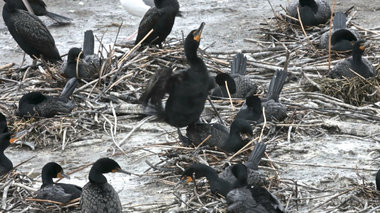
Fishery managers and researchers engaged in salmon and steelhead recovery efforts need to better understand, and address, issues related to what has become a smaller and less hospitable Columbia River basin world, according to a Feb.25 report issued by the region's Independent Scientific Advisory Board.
The new report says that "Many salmon populations throughout the interior of the Columbia River basin are experiencing reduced productivity associated with recent increases in natural spawning abundance, even though current abundance remains far below historical levels.
"Density dependence is now evident in most of the ESA-listed populations examined and appears strong enough to constrain their recovery."
A total of 13 salmon and steelhead stocks are listed for protections under the Endangered Species Act.
Why is this happening? the ISAB asks. And answers.
- "The ISAB concludes that historical all-species capacity was likely in the range of 5 to 9 million adult fish per year, which is less than previously published estimates (e.g., 7.5 to 16 million adults per year) but still much higher than current abundance levels (~2.3 million fish per year during 2000-2012).
- "Evidence for strong density dependence at current abundance suggests that habitat capacity has been greatly diminished. Roughly one-third of the Basin is no longer accessible to anadromous salmon, and continuing changes to environmental conditions stemming from climate change, chemicals, and intensified land use appear to have further diminished the capacity of habitat that remains accessible. Density dependence was also observed in some less altered watersheds," according to the executive summary
- "Hatchery releases account for a large proportion of current salmon abundance. Total smolt densities may be higher now than historically. By creating unintended density effects on natural populations, supplementation may fail to boost natural origin returns despite its effectiveness at increasing total spawning abundance.
- "Identifying mechanisms that contribute to density dependence in particular habitats and life stages -- such as limitations in spawning habitat, rearing habitat or food supply, or predator-prey interactions -- can help to guide habitat restoration and population recovery actions.
- "Understanding density dependence (e.g., stock-recruitment relationships) in salmon populations is central to evaluating responses to recovery actions and for setting spawning escapement goals that will sustain fisheries and a resilient ecosystem."
The report, "Density Dependence and Its Implications for Fish Management and Restoration in the Columbia River Basin" can be found at: www.nwcouncil.org/fw/isab/isab2015-1/
"In response to a March 2014 assignment from the Northwest Power and Conservation Council, NOAA Fisheries, and Columbia River Indian tribes, the Independent Scientific Advisory Board (ISAB) reviewed the implications of density dependence in fish populations in the Columbia River Basin," according to the document's executive summary.
The 11-member ISAB was established in 1996 by the NPPC and NOAA Fisheries to provide on request independent scientific advice and recommendations regarding scientific issues posed by the respective agencies on matters that relate to their fish and wildlife programs. Columbia River Basin tribes were added as equal and permanent partners in the sponsorship of the ISAB.
The ISAB's key recommendations listed in the report's executive summary include:
- Anadromous salmonids
- Account for density effects when planning and evaluating habitat restoration actions.
- Establish biological spawning escapement objectives that account for density dependence.
- Balance hatchery supplementation with the basin's capacity to support existing natural populations by considering density effects on the abundance and productivity of natural origin salmon.
- Improve capabilities to evaluate density dependent growth, dispersal, and survival by addressing primary data gaps.
- "Non-anadromous salmonids
- Recognize that carrying capacity for non-anadromous salmonids can be increased by restoring in-stream structure and riparian vegetation.
- Recognize that carrying capacity for non-anadromous salmonids can be reduced through competitive interactions with stocked hatchery trout or invasive non-native trout.
- Consider the probable effects of density on survival, emigration, growth, and size/age at maturity when developing angling regulations to achieve conservation and recreational goals.
- Sturgeon
- Consider habitat capacity and the probable effects of density on growth and survival when developing stocking programs to conserve white sturgeon.
- Lamprey
- Initiate studies to gather information about current densities of Pacific lamprey in the Basin and to learn about density dependent processes that might thwart efforts to promote their recovery.
- Consider lessons learned about supplementation and density dependence in anadromous salmonids when planning future actions to propagate and translocate (i.e., supplement) lamprey within the Basin.
Related Pages
The Density Dilemma: Limitations on Juvenile Production in Threatened Salmon Populations by Walters, Copeland, Venditti, Ecology of Freshwater Fish, 2/25/13
Staff
Independent Science Board: 'Density Dependence,' Diminished Habitat Constraining Salmon Recovery
Columbia Basin Bulletin, February 27, 2015
See what you can learn
learn more on topics covered in the film
see the video
read the script
learn the songs
discussion forum




